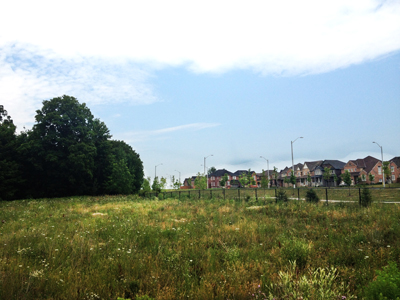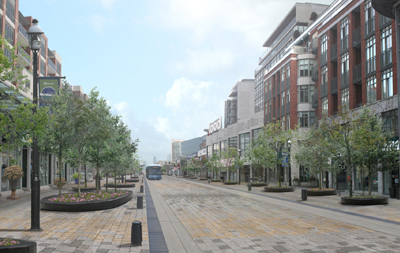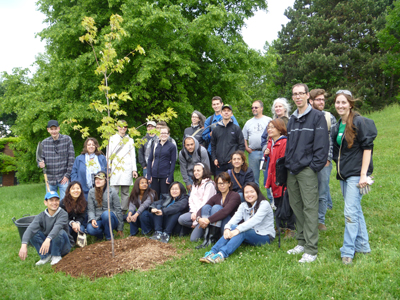Is Markham well-poised to address this - and can it be a leading example for other Canadian municipalities? The city’s comprehensive streetscape manual cites limited growing space, poor soil and site conditions, and limited implementation of good policies and practices as just some of the threats to urban trees. And as in many other Ontario communities, invasive pests, plants and diseases also pose threats to local tree populations. The most important of these is currently the Emerald Ash Borer, which threatens to eliminate some 9% of the city’s urban forest (York Region Emerald Ash Borer Management Plan).
The challenges facing Markham’s urban forest can be found in many other communities, but the city has a number of programs and policies to address each and every one. A Tree Preservation By-law protects significant trees, and a fund supports urban forest initiatives between its borders.

A new subdivision growing outwards on the west side of Markham stands next to a well preserved woodlot.
In 2010, while it was still just a town, Markham nearly doubled its goal to plant 75,000 trees through its Trees for Tomorrow Program. As it turned out, they had planted over 125,000 before the summer even started. But tree planting alone does not ensure sustainability in an urban forest. Among other considerations, locations much be carefully chosen - and improved if necessary - and trees must be given appropriate care long after planting has taken place.
In recognition of these facts, Markham developed the leading-edge streetscape manual I mentioned above. It not only points to potential problems, but also outlines specifications and guidelines for all stages of the tree establishment process in the city. This covers everything from planning and design, to tree selection, planting and maintenance. It even encourages innovative practices such as engineered rooting environments, which provide adequate soil volumes for large-growing trees.
Through the implementation of informed practices, Markham will realize many important urban forestry objectives, such as greater biodiversity, increased tree establishment rates and, over time, increased leaf area and canopy cover to benefit all residents.

Adequate soil volume and quality will be necessary to ensure survival and growth of trees planted in Downtown Markham, above is a proposed rendering of what will be GTA’s first transit-pedestrian mall.
What’s more, these are topics taught in Tree Tenders Volunteer Training Program. The course, offered by LEAF and supported by the City of Markham, helps residents contribute to the urban forest that the city is working to build. Together we aim to teach residents about the benefits of a healthy canopy and what everyone can do to make it a reality.
So can the streetscape manual and support for educational programs can serve as a model for other municipalities, as few have such comprehensive and detailed guidelines for effective tree establishment, maintenance and community engagement? I think so.

Tree Tenders following the tree planting section of the course during one of our spring sessions.
If you want to find out more about what Markham is up to when it comes to their trees, check out their Parks Department Urban Forestry Section web page. And if you want to get involved, join us on September 22 for the first session of our Tree Tenders Volunteer Training Program at the Rouge River Community Centre.
Alex Satel is an instructor for the Tree Tenders Volunteer Training Program and a consultant with Urban Forest Innovations Inc., an Ontario-based urban forestry and arboricultural consulting firm. He has been involved in the development of urban forest management plans for several communities in Ontario, and consults on a variety of issues including tree protection during construction, tree risk assessment and urban forest health.
